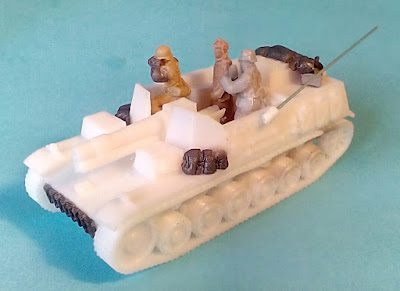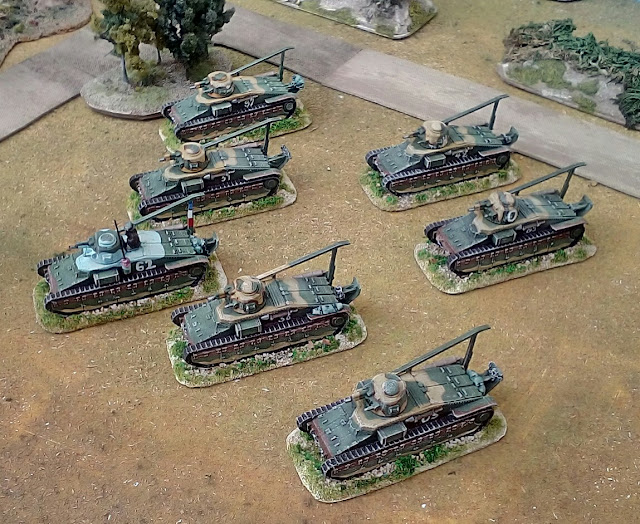With the Tobruk defences in the line of sight, an Arko 104 officer of the Heeres Küsten-Artillerie-Abteilung 533 - writing German makes me look much more cultivated under your eyes!!- directs the fire of the famous 'Bardia Bill' right into an Australian position. The second 'Bardia Bill' (first were Italian) was an ex French GPF 155mm gun in usage by the Germans that became famous together with "Salient Sue" for the shelling of the Tobruk perimeter.
The gun is a MiniGeneral 3d print with soft and hard plastic crew. The ones born in the late 60s may recognize the bayonetting Airfix DAK figures now serving as artillerists ramming the shell into the breech of the gun.
The Mauser of the left figure was simply cut out and the figure was ready to hold the ram. The figure to the right required more work as the original figure is attacking with the weapon above his head. So new arms were made from two component paste and due to the group having to be in place while the ram was glued, the figure got Popeye arms! Or at least its my excuse.
The other two figures are the famous DAK Airfix officer and an Esci figure from the Nebelwerfer set in winter suit but that can become a passable Afrika Korps artillerist even if probably sweating more than it should.
The tow for 'Bardia Bill' is a 3d printed Sdkfz 7 from BPM 3d. The limber was scratch built and generically copied from another one I have from Alby. No wheels with seven spikes in the left over boxes so I used the ones offered in the Hat WW2 French artillery set of figures. Not exactly the same but at least they have seven spikes and speak French!
After painting the result is reasonable. The figure seating on the limber... Any guesses?... No?... Ok, its the Airfix Luftwaffe figure kneeling with a bomb in a upright position. The right leg was repositioned, the left arm replaced and a new field cap glued was to the original head.
The idea came from some nice pictures Richard Baber found of the towing vehicle of the 15,5cm K418(f). Later I found another image and more information about Arko 104 and 'Bardia Bill' in the French magazine Batailles &Blindés Hors Série No26.
A third Bison II was added to the 90. Leichte Division this time from MiniGeneral 3d prints. I already have another two from BPM and those would be enough to represent the 12 ever made and used by the 90.LD but I just like the vehicle and if one model tank represents five in RF! terms it can also represent four specially because its Christmas.
The crew figures are all conversions from Revell, Airfix and Esci.
The model is quite detailed but a few more extras makes it more lively.
Returning from Benito's Anniversary (see this blog two posts ago) I added this Altaya Macchi 202 Folgore...
... and this Macchi 205 Veltro fighters. The Veltro was a particularly good fighter and one of the few in the Axis arsenal that could put on a fight with the P51D Mustang.
A big Thank You to Richard Baber as he stopped me from taking a Somua to Lybia to tow 'Bardia Bill'.
Next: Normandy 44 a few more12th SS HJ soft skins.



















































